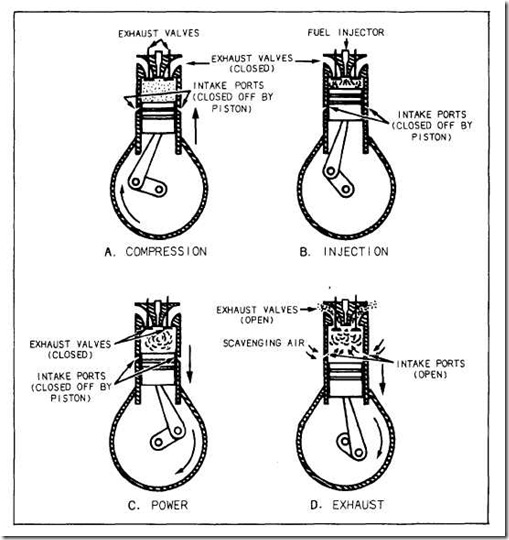To study two stroke and four stroke Diesel engines.
AIM: To study two stroke and four stroke Diesel engines.
APPARATUS: Model of two stroke and four stroke Diesel engine.
THEORY: The engine which converts the heat energy into mechanical energy is known as heat engine.
Working principle of four stroke Diesel engine.
There are four strokes as:
1. Suction Stroke
2. Compression stroke
3. Expansion stroke
4. Exhaust stroke
1. Suction stroke: This stroke starts with the piston at top dead centre position. The inlet value is opened and the exhaust value is closed. The downward movement of the piston creates vacuum in the cylinder due to which air is drawn into the cylinder. The movement of the piston is obtained either by the starter motor or by the momentum of the fly wheel.
2. Compression stroke: This stroke starts with the piston at B.D.C. position. Both the inlet and exhaust values are closed.
The air sucked during the suction stroke is compressed as the piston moves in the upward direction. A few degree before the completion of compression stroke, a very fine spray of diesel is injected into the compressed air. The fuel ignites spontaneously.
Figure of CI Engine Cycle
3. Expansion stroke: Both the inlet and exhaust valves remain closed. The heat energy released by the combustion of the fuel, results in the rise in pressure of the gases. This high pressure rise drives the piston in the downward direction, thereby producing some useful work. This stroke is called as power stroke.
4. Exhaust stroke: This stroke starts with the piston at the B.D.C. position. The inlet value remains closed whereas the exhaust value is opened. The upward movement of the piston pushes the burnt gases out of the cylinder through the exhaust valve. At the end of exhaust stroke, the exhaust valve is also closed.
The four-strokes complete one cycle which may repeat again to produce power.
WORKING PRINCIPLE OF 2 STROKE DIESEL ENGINE
1. 1st Stroke – As the piston starts rising from its B.D.C. position, it closes the transfer and the exhaust port. The air which is already there in the cylinder is compressed. At the same time with the upward movement of the piston, vacuum is created in the crank case. As soon as the inlet port is uncovered the fresh air is sucked in the crank case. The charging is continued until the crank case and the space in the cylinder beneath the piston in filled with the air.
2. 2nd Stroke – Slightly before the completion of the compression stroke a very fine spray of diesel is injected into the compressed air (which is at a very high temperature). The fuel ignites spontaneously.
Figure of Two stroke CI Engine
Pressure is exerted on the crown of the piston due to the combustion of the air and the piston is pushed in the downward direction producing some useful power. The downward movement of the piston will first close the inlet port and then it will compress the air already sucked in the crank case.
Just at the end of power stroke, the piston uncovers the exhaust port and the transfer port simultaneously. The expanded gases start escaping through the exhaust port and at the same time the fresh air which is alredy compressed in the crank case, rushes into the cylinder through the transfer port and thus the cycle is repeated again.


3 Responses to “To study two stroke and four stroke Diesel engines | BME Lab Manual”
shwetha
Thank u. It was very helpful to me
VIJAY RAMESH
THANK YOU SIR
ravi
port open at what degree digram ia not here